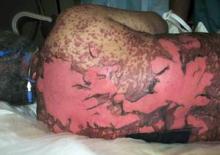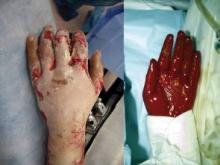NEW ORLEANS - Their presentation can be alarming, even for dermatologists accustomed to seeing all kinds of adverse skin manifestations. Widespread necrosis, skin detachment, erythema, large bullae, and more are seen in patients with the life-threatening drug eruption, toxic epidermal necrolysis.
Medical management with intravenous immunoglobulin and a focus on supportive care save lives at the University of Miami, a toxic epidermal necrolysis (TEN) referral center.
"The survival rate is extremely low for this set of patients," Dr. Carlos A. Ricotti said at the annual meeting of the American Academy of Dermatology. But "the outcome at the University of Miami is very good. We see these patients, and we have a good understanding they are going to leave the hospital well."
Medical management is swift and comprehensive. "Assume there will be fluid loss, possible infection, impaired thermal regulation, altered immunity, and increased energy expenditure," Dr. Ricotti said. "Each of these has to be addressed."
In addition, despite a clinical appearance similar to that of burns, recognize that patients with TEN differ from burn patients in important ways, said Dr. Ricotti, who is on the dermatology staff at the University of Miami Hospital. TEN patients typically feature less edema, minimal vascular damage, and less damage to regenerative tissue, leading to faster re-epithelialization, compared with burn patients. "The rate of healing is much faster."
The hospital's dermatologic medical management of TEN begins with withdrawal of offending medication. Because patients present with a burning sensation, pain control is essential to achieve comfort and to decrease their movement during recovery.
Think in terms of "acute skin failure" when providing supportive care, Dr. Ricotti said. Consider medical ICU or a burn unit admission; an air mattress with pressure ulcer prophylaxis; nonstick sheets and heating blankets; and maintenance of room temperature at 30° C.
"We don't do debridement," Dr. Ricotti said. Pathology reveals that the entire dermis is not necrotic. The remaining viable tissue can act as a natural biologic dressing that may retake as a graft. "This speeds re-epithelialization ... and we believe this speeds recovery of the patient."
By day 6-10 of admission, most of the skin erosions re-epithelialize (as opposed to second-degree burns, which can take 14 days or longer). Because of this rapid tissue regeneration, patients require high caloric intake, which can include total parenteral nutrition or feeding via a nasogastric tube.
Strict fluid monitoring is essential, Dr. Ricotti said. "We feel very strongly about [fluid management]. We feel this plays an important role in our excellent outcomes." They typically administer IV fluids with half normal saline and 20 mEq KCl. Fluids in and out are monitored with a urine output goal of 40-80 mL/hr.
"We know that in TEN, there is potential for alveolar/epithelial barrier alteration due to the systemic nature of the disease," Dr. Ricotti said. "Our working hypothesis is that by decreasing fluid overload, we can minimize pulmonary involvement and improve outcomes." He recommended reading the results of a prospective clinical trial for more insight into the management of pulmonary complications (Intensive Care Med. 1997;23:1237-44).
Not only is intravenous immunoglobulin (IVIG) therapy important, the total dose makes a difference, Dr. Ricotti said. Survival increases significantly with each 1-g/kg increase in IVIG dose (odds ratio 4.2), according to a review article (Expert Rev. Dermatol. 2007;2:299-303).
A typical IVIG protocol at the hospital is 1 g/kg per day for 4 days, Dr. Ricotti said in response to a meeting attendee’s question. "The higher the dosage, the better the outcome." Although IVIG is essential, so is treatment at a center of excellence with special expertise in treating patients with drug eruptions.
TEN know-how also is important, he said, because "with its low incidence, it's difficult to perform large, multicenter prospective trials."
Infections can occur. Cutaneous infection, pneumonia, and subsequent life-threatening sepsis are well-recognized complications of TEN. However, "we refrain from using empiric antibiotic therapy," Dr. Ricotti said.
They do routinely provide anticoagulation prophylaxis with heparin to prevent deep vein thrombosis, gastrointestinal prophylaxis with proton pump inhibitors, and eye care with tobramycin and dexamethasone.
TEN is relatively rare, with an estimated incidence of 1 person per million per year. Even so, "we see drug eruptions all the time in inpatient units," Dr. Ricotti said.
In addition to TEN (classified as "with spots" or "without spots" by extent of skin involvement), other drug eruptions include erythema multiforme major, Stevens-Johnson syndrome (SJS), and patients who have an overlap of SJS and TEN. Consider staphylococcal scalded skin syndrome and TEN with drug hypersensitivity syndrome in your differential diagnosis, he added.



